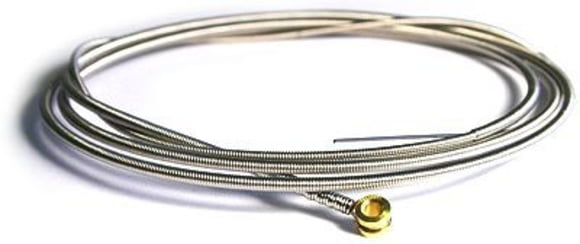2. String Basics
Strings come in many different varities, but rather than purchase them singly, most players buy strings in standard packs. These are sets of strings that are designed to work well together - in other words, they all feel equally light or heavy from top to bottom. Although experienced players occasionally pick and mix unusual combinations to suit a particular playing style, and many manufacturers offer custom sets, the vast majority of players stick with the standards.
Gauge
One of the basic properties of any string is its thickness or gauge. This is usually given in inches, and sometimes also in millimetres. For example, a popular gauge of top E string for the electric guitar is 0.010 (inches) or 0.25mm. This is usually referred to simply as a ten. Standard sets are officially described as light gauge, heavy gauge and so on, but most musicians just use the top string gauge to describe the whole set, e.g. a set of nines or a set of tens.
Plain & Wound
Strings are made from a number of different materials in various combinations, but almost all sets combine plain and wound strings. Plain strings are made from a single material - usually some kind of steel - whereas wound strings combine an inner core with an external winding, usually of a different material. The higher strings are generally plain, and the lower strings are normally wound - p and w are commonly used to denote this. Since the two highest strings (B and E) are almost always plain, and the three lowest (E, A, D) nearly always wound, this information is often applied solely to the third (G) string, which may be either plain or wound depending on the type of guitar and the playing style. For example, the strings in a standard set of electric tens are usually listed as 010-013-017p-026-036-046, indicating in this case that the G string is plain. (Bass guitars use wound strings only, as you would expect given that the strings are an octave lower than the bottom four guitar strings.)

Wound strings come in several varieties. Most wound strings are technically roundwound - the winding is made from round wire. This results in a ribbed outer surface.
Flatwound strings are wound with square section wire. This results in a much smoother outer surface.
Flatwound strings feel much smoother under the fingers, cause less fret wear and sound warmer than roundwound strings. Many jazz players favour this warmth, but most rock players prefer the brightness of roundwound strings. Halfwound or groundwound strings represent a compromise - the core is wound with round wire which is then ground down to produce a smooth outer surface. This combines much of the brightness of roundwound with the smoothness of flatwound. Halfwound strings tend to be expensive as the manufacturing process is more involved and incorporates a degree of wastage.
Hex Core
Hexwound strings are a recent innovation - in this case, hex refers to the shape of the core rather than the winding.
Manufacturers of hexwound strings cite various claims of superior tonal characteristics. While theres little consensus on this among players, their sharp edges do result in more fret wear than even roundwound strings.





